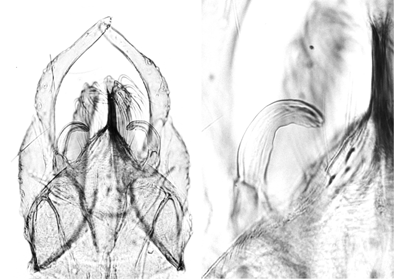Chironomus bicoloris Tokunaga, 1964 Type data: holotype USNM US66552 adult male, paratype(s) USNM 2 adults male. Additional specimens: Wing length: 2.96-3.76 mm.; wing width 0.80-0.86 mm.; VR about 1.0. Brown spot over crossvein; usually 4, or 3, Scf on brachiolum; 22-23 setae on squamal fringe. AR about 3.10-3.16. Frontal tubercles longer than in Micronesian specimens - about 50-60 micron and 2.5-2.8 times longer than wide, longer than the width of two eye facets. Clypeus width about 157-170 µm, about 0.75 of diameter of antennal pedicel; with about 27-33 setae. Palp proportions (µm): 66 : 64 : 253 : 249 : 436; P5/P4 1.53, P5/P3 1.66. Thoracic setae - about 19 acrostichal; 26-30 dorsocentral; 1 supraalar; 6-7 prealar; 28-37 scutellar - 12-17 in 1 or 2 anterior rows and 16-20 in posterior row. Legs with femur and tibia greenish, tarsi yellowish with at least slight darkening of knees and at tips of tarsi. Lengths (microns) and proportions as follows:
 C. bicoloris: Male hypopygium (left) and superior volsella (right) Tergite IX with 14.3 (13-16) setae in a large single patch. Inferior volsella reaching to about the end of the anal point; setae forked. Colour yellowish, with brown vittae; legs as in males. Wing length 3.42 mm., width 0.89 mm.; VR 0.91. 3-4 Scf on brachioum; 17-18 setae on squamal fringe. Relative length of antennal segments (micron) (proportion of neck in brackets): 164 (0.25) : 109 (0.38) : 124 (0.44) : 118 (0.45) : 182. Frontal tubercles about 22 µm long and 2.5 times longer than wide. Clypeus about 1.7 times the diameter of the antennal pedicel, with 35 setae. Palpal proportions (micron) 63 : 48 : 188 : 250 : 385 (P5/P4 1.54; P5/P3 2.05). Thoracic setae: acrostichal abt 14; humeral 5-6 linear; dorsolateral 22 (humeral+dorsocentral 27-28); prealar 3; supraalar 1; scutellar with 2 rows - 7 in anterior row and 10 in posterior row. Leg lengths (micron) and proportions
 Cercus and segment X (at left) of C. bicoloris Cercus shorter on the dorsal margin, posterior margin slighly curved towards ventral end and merging into the longer ventral margin with a basal bulge. Found: Queensland - Lake Boemingen and Lake Wabby (25.27°S, 153.80°E), Fraser Island (25.15°S, 153.10°E)(H. burton, light trap); 3 km w. Sarina Beach (21.40°S, 149.25°E). |
Modified: 12 November 2022
Access: Unrestricted
Copyright © 2005-2022, Jon Martin.